The Norwegian writer Karl Ove Knausgaard is a 21st-century literary phenomenon. Talked up as a contender for the Nobel Prize in Literature, he has been compared to some of the greatest writers of all time: Fyodor Dostovesky, Marcel Proust, Roberto Bolaño. His work challenges conventional assumptions about content and form, and resonates with readers across the world.
Knausgaard’s magnum opus – the six-volume, 3,600-page autofictional epic My Struggle (Min Kamp) – has been translated into 35 languages. It’s sold half a million copies in Norway alone – a remarkable statistic, as Norway’s population is roughly five million.
Cultural commentator Jesse Baron summed up its impact:
“Knausgaard has written one of those books so aesthetically forceful as to be revolutionary. Before, there was no My Struggle; now there is, and things are different.”
In 2020, Knausgaard followed up his “revolutionary” bestseller with The Morning Star (Morgenstjernen), the first in a new cycle of novels.
By turns didactic and entertaining, the action of this enormous novel revolves around the sudden appearance of a massive new star in the sky, which may or may not herald the arrival of Lucifer on planet Earth. The dead seem to be coming back to life. Norwegian black metal might have something to do with it all. (And yes, you did read that last sentence correctly.)
Knausgaard’s new, unabashedly formidable novel, The Wolves of Eternity (Ulvene fra evighetens skog), is set in the same fictional universe. In terms of plot, however, this only becomes fully apparent near the end, when the mysterious star appears in the sky – and it’s revealed there haven’t been any registered deaths in Norway for three whole days.
Early joy at ‘being able to write’
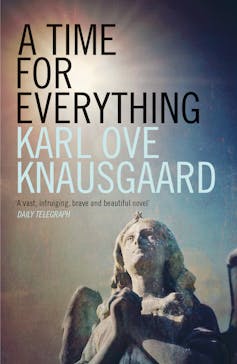
Knausgaard, who is arguably the most famous Norwegian writer since Henrik Ibsen, was born in Olso on 6 December 1968. He was raised on Tromøy, the largest island in southern Norway, and studied at the University of Bergen.
As a student of creative writing, Knausgaard was taught by Jon Fosse, the 2023 Nobel Laureate. After graduating from university, he taught at high school in northern Norway and spent time working in a psychiatric hospital. He also had a stint labouring on an oil rig.
In 1998, after moving to Sweden, Knausgaard released his first novel, Out of the World (Ute av verden). In part concerned with Knausgaard’s relationship with his alcoholic father, this autobiographically inflected book was a hit in Norway. It received the Norwegian Critics Prize for Literature: the first time in the award’s history a debut novelist walked away as winner.
Knausgaard is now critical of his first novel. “It is the work of the beginner,” he says, “and it is blemished by an at times obtrusive self-infatuation, the joy of being able to write.”
He is much fonder of his second book, which appeared to mixed reviews in 2004. In Knausgaard’s words, A Time for Everything (En tid for alt) is a novel “about angels, like angels do exist, they really were around. The mystery in the book is where did they go? It’s a retelling of the stories in the Bible.”
Yet he readily concedes “nobody else is interested in [it] because it’s the most fictional” of his novels.
My Struggle changed the novel
Knausgaard is nodding in the direction of My Struggle, which launched him into the literary stratosphere. This provocatively titled autobiographical novel cycle spans six books, published between 2009 and 2011. Taken together, it is the longest novel in Norwegian history.
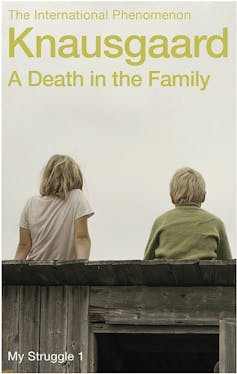
Academic Claus Elholm Andersen argues this monumental work “has become the preeminent example of autofiction and has changed how we conceive of novels”.
Knausgaard has been candid about the fact that My Struggle, which traffics in the minutiae and rhythms of daily existence, “came out of a great frustration” in his life.
The writer, who had recently become a father, was suffering from a severe case of writer’s block. Knausgaard was also stuck in what he subsequently characterised as a midlife crisis:
“Another thing is that when I turned forty it was kind of like I was dead. I thought “This is it and it’s going to be like this for the rest of my life”. And the only way for me to deal with that was through literature. It’s difficult to explain but I had to attempt to get closer to life, which is a stupid thing to do but that’s what I was trying to do, to avoid all the structures and forms of the novel.”
Knausgaard realised he had to change his approach to writing in order to get closer to life. Speed of composition became “the most important thing” for Knausgaard. He recalls that speed served a practical function
“because I am a perfectionist in my writing, in my way of thinking, and I want to make it into real art, real literature. But I had to fight against that thing in me because I became so critical of my own writing, and I needed to get over that, and the only way I could do it was by speeding up because then you don’t have time to be critical at all.”
The goal he set himself was to write a specific number of pages every day. “In that way I simply wouldn’t have time to think, to plan or to calculate,” Knausgaard explains, “I would have to go with whatever appeared on the screen in front of me.”
The number of pages per day soon started to go up. Five, ten, twenty. Knausgaard holds that this allowed him
“to escape the notion of knowing what to write. If you know what you’re going to write then that’s death for me, then nothing is happening. If I plan something it’s just dead. And almost everything I write is dead in that sense really, but if I speed up then something, all of a sudden, is happening because I can no longer control it.”
But this new method came with risks. Quality control was an issue. Knausgaard is the first to admit there is “a lot of bad writing” on display in My Struggle, which deliberately privileges quantity over artistic quality.
This shift became more pronounced as he went along. “When the books started to be published,” Knausgaard remarks, “I had incredibly tight deadlines, which was a great help. Then I couldn’t afford to think about quality, only quantity mattered.”
Knausgaard is underselling himself a bit here. In the reckoning of the literary critic James Wood, Knausgaard’s hypnotic prose is
“intense and utterly honest, unafraid to voice universal anxieties, unafraid to appear naïve or awkward. Although his sentences are long and loose, they are not cutely or aimlessly digressive: truth is repeatedly being struck at, not chatted up.”
‘No topic is off-limits’
Knausgaard’s candour is part of his appeal, but he seems to have been genuinely taken aback by the public’s response to My Struggle. He confessed as much to the journalist Liesl Schillinger:
“It’s bad. I wrote it rather blindly, I didn’t think it was exceptional. I thought this would be a minor literary book, I thought it would be a step down from my other books, I thought maybe it was boring and uninteresting and really about nothing.”
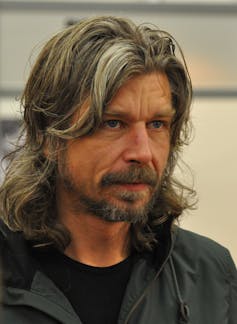
Knausgaard’s many readers would beg to differ. We warm to what we might describe as his radical openness, and appreciate his willingness to discuss subjects society tends to regard as shameful and taboo. Sexual inadequacy, self-harm, Adolf Hitler. No topic is off-limits, everything is up for discussion.
This has occasionally made life difficult for Knausgaard. Some of his nearest and dearest have taken umbrage at the way they are presented in My Struggle.
Feminist commentators have been troubled by Knausgaard’s opinions about sexuality and gender relations in contemporary Europe. For example, in the second volume of My Struggle, he expressed scepticism about how “modernised and feminised” parameters of “equality and fairness” impact on masculinity.
Knausgaard acknowledges the criticism his work has generated in some quarters:
“I am accused of being right-wing and antifeminist or antiwoman even – all kinds of things – but I think if you read the whole book and see it … what I seek is complication.”
My Struggle famously ends with Knausgaard declaring he is no longer a writer. However, his output across the past decade directly contradicts that statement.
He’s been a consultant on a new Norwegian translation of the Bible and published several nonfiction books, on subjects as diverse as football and the art of Edvard Munch.
And he has contributed a novel, The Blind Book (Blindenboken), to the ecologically inspired Future Library initiative, a series of original works printed on paper made from a thousand freshly planted trees. It will be held in trust, unpublished, until 2114, when it will be printed and released.
“From a writer’s perspective,” Knausgaard reflects, “it is incredibly fascinating to do something and to know that it is [going to] be published in a completely different setting in a completely different world probably.”
The Morning Star ‘divided critics’
The Morning Star, Knausgaard’s first stab at fiction since My Struggle, is a speculative novel set in the here and now, in a recognisable version of our world. It has divided critics. Bloated and inconsequential, compulsive and haunting – people can’t seem to make up their minds about it.
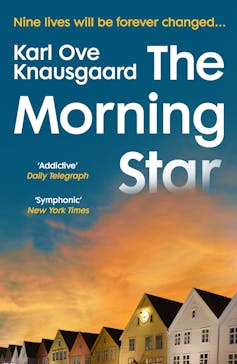
Part of the problem, I think, has to do with the sheer scope of the work – which is exactly 666 pages long.
Divided into three sections and featuring nine narrators, the novel, much like My Struggle, is punctuated by a dizzying number of theological and philosophical detours.
Take the following example. One of the narrators, Kathrin, has invited a couple of friends – Sigrid and Martin – for dinner. Martin is a perennial student. By the time we meet him, he has already failed to finish degrees in philosophy, computer science and biology. To Sigrid’s despair, he now wants to write about trees. Here is Martin’s almost painfully earnest take on the topic:
“The mind is a kind of place where we become visible to ourselves. But why? What’s it good for? When we see ourselves, we see ourselves from without – the way others see us, in other words. That was what Nietzsche understood, that the mind exists for the good of the community. It’s there for what goes on between people. And that’s where some scholars believe there to be other kinds of consciousness too. Other forms of intelligence. The forest, for instance. The point being that those kinds of consciousness – intelligence, if you will – are so alien to us that it’s hard for us to see that they even exist.”
This is how characters in Knausgaard’s novels tend to talk. The question being asked here is basically: can a tree think? The answer, according to Martin, is not clear cut:
“So a tree can’t think,” Martin went on. “But the trees can. The ecosystem as an entity can. The fact that such an idea is being talked about now is probably down to people trying to construct forms of AI. We don’t know what that’s going to look like either.”
These passages are typical of Knausgaard, who believes the power of the novel resides in its unique ability to pull
“any abstract conception about life, whether political, philosophical or scientific in nature, into the human sphere, where it no longer stands alone but collides with myriad impressions, thoughts, emotions and actions.”
This accounts for the wildly digressive shape of The Morning Star, which is best understood as a contemporary spin on a tried and tested literary genre: the novel of ideas.
Wolves of Eternity
Published in 2022 and translated into English in 2023, The Wolves of Eternity shares several thematic and formal traits with The Morning Star. Like its immediate predecessor, the novel, which starts in 1986, contains a number of first-person narratives. Two in particular stand out.
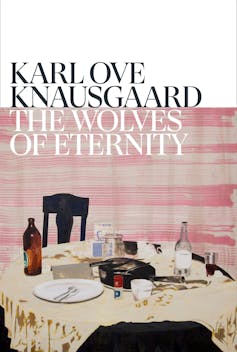
Syvert Løyning has been released from Norwegian military service. He has just moved back home and needs to earn some cash. He eventually finds work as an undertaker. One day, while at home, he happens upon a stash of old letters from his late father to a lover living in the Soviet Union. He gets them translated, and discovers he has a half-sister, Alevtina, who works as a scientist. They eventually meet up in Putin’s Moscow.
The novel ends on an ambiguous and vaguely ominous note, with Syvert leaving Russia and heading back to Norway, which is in the throes of an extreme heat-wave. The morning star is hanging in the sky:
“I slung my jacket over my arm, picked up my suitcase and bag and went down to the lobby, where my taxi was already waiting for me. Outside, the light from the new star shone in the grey sky above us, as if through a shroud.”
If anything, The Wolves of Eternity is even more ambitious than the book that came before it. The Morning Star is set in Norway and takes place over two consecutive days in late August. The plot of The Wolves of Eternity unfolds across Europe over decades.
Clocking in at a formidable 789 pages, it dwarfs its predecessor in length, too. Like The Morning Star, The Wolves of Eternity looks to tackle the most daunting and momentous of topics.
The meaning of life and the undoing of death. Scientific and political revolution. The nature of atoms and the history of the cosmos. Transhumanism and the existence of God. These are but a few of the matters Knausgaard concerns himself with in his new novel. Trees feature, too:
“All organisms lived in such pockets of time, whose settings differed from species to species, in which their life cycles ran their course, complete for every individual, filled to the brim with life in time. The trees had no brain either, nor any central nervous system, and this of course defined their existence too, the way systems of sensory perception defined the existence of all things living on earth, meaning that the world looked quite different to a fly than it did to a cow or a tree.”
I quote at length from Alevtina’s narrative because it’s important to give you a sense of what you are getting yourself into, if you decide to take the plunge into Knausgaard’s latest. Like My Struggle, it was written at impressive pace to deadline.
Knausgaard accepts that The Wolves of Eternity is a very challenging book to read. This is mainly because the plot, in the author’s words, “moves very, very, very slowly”.
Some readers may bristle at (or even be put off by) the prospect of this. But the more time I spent with the novel, the more I came to appreciate that its length and pacing serve a specific, indeed vital, function.
It forces the reader to take stock, to grapple with precisely the sorts of complications Knausgaard is interested in pursing in his work.
This, admittedly, is not for everyone. Still, I think there is something truly remarkable, even admirable, about Knausgaard’s willingness to stick to his guns when it comes to seeing what the novel form is capable of doing and containing.
As to what comes next, I’m not entirely sure. But I’m quietly confident it’ll be suitably epic.
This article was published by The Conversation.














